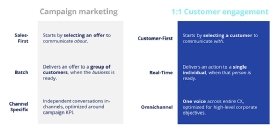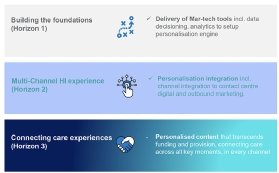Private healthcare company Bupa, which provides health and insurance services to 7.2 million people in Australia and the Asia-Pacific (APAC) region, is rolling out technology to allow it to communicate with its customers in a personalised way, through email, mobile phones, the web and call centres.
Over the past four years, the non-profit organisation has reorganised its IT systems to reach a point where the majority of its customers prefer to interact with the company “digitally” over the internet, mobile phone and email.
The project has led to the company making nearly seven million digital interactions with customers a year, and to a 17% annual growth in customers “actively engaging” with the company. Bupa claims to be close to the point where 100% of insurance claims can be processed electronically.
The work has required an internal shift in the way the healthcare organisation thinks about offering private insurance and services including dental, hearing, eyesight and residential care for the elderly.
Cale Urwin, director of digital marketing and health services at Bupa, based in Melbourne, Australia, told Computer Weekly that Bupa APAC has been able to link computer systems and data across its business so that the company is able to see a single record of each customer’s history and circumstances.
This has enabled it to switch its focus away from offering products towards offering people a personalised service based on their needs and circumstances.
“Where we previously had different views of customers, we now have a single view of each customer, and we’re able to ensure that the right messages get to the right customers,” he said.
The company has rolled out decision-making software supplied by Pegasystems to allow it to send personalised updates and marketing messages.
Perhaps more importantly, Bupa can ensure that marketing messages are not sent to people inappropriately – for example, when a family member is ill.
“If someone’s going through a high-acuity experience or a family member is, we would suppress marketing activity that would be otherwise reaching that customer,” said Urwin.
Covid was a catalyst
The pandemic in 2020 was a catalyst for Bupa to rethink its services. People with Bupa insurance were unable to access healthcare as easily or take advantage of their full range of health benefits because of lockdown restrictions.
The company began working on its internal architecture, identifying where it would like to go, as well as gaps in its infrastructure.

It started with the largest part of Bupa’s business, Private Health Insurance, which according to Urwin was the “biggest opportunity to drive value”.
Bupa began a three-stage programme to update its infrastructure. It bought in software to analyse customer data and develop what it calls a “persuasion engine” to send personalised marketing offers and updates to its clients.
The heart of the operation is its Customer Decision Hub software, developed by US company Pegasystems. It allows Bupa to conduct two-way conversations with customers and analyse billions of data points to determine the right recommendations for each person.
The company initially sent a team to spend three days with Pega’s US headquarters near Boston, working with the company’s specialists to map out how Bupa wanted to develop its IT architecture.
During stage two, between 2022 and 2023, Bupa linked different communications channels, including its contact centre, digital channels and outbound marketing services, so it could ensure that clients received consistent messages.
Heathcare services
The focus for 2024 is adding healthcare services, known internally as “provisioning” businesses into its Customer Decision Hub.
Integrating these businesses is challenging, as healthcare relies heavily on human labour and outdated technology such as fax machines, said Urwin.

“Convincing dentists across our network to give up their favourite Patient Management System – never mind adopting a new one – is incredibly challenging,” he said.
But it could also help customers get more value out of their Bupa health insurance.
“The ability for our members to see value and perceive value is when they’re actually interacting with the product – and that means they have to be consuming services,” said Urwin.
The project will mean cleaning up and upgrading the company’s legacy technology to combine multiple records to allow Bupa to have a “single view” of each customer.
“We will have the ability to see that customer at an individual level and know the existing relationships with our Bupa-branded businesses, and then how we can serve them optimal experiences,” he said.
From products to people
Urwin said one of the biggest challenges for the project is that Bupa’s operations are built on different technologies based on different data models.
Legislation requires Bupa to store some records as “membership IDs”, but its healthcare businesses may, for example, store records of customers by name.
The challenge will be to link records of customers which may be stored differently by each business. “Building out a 360-degree view of customers in a safe, compliant and trusted way is really a sharp focus for us,” he said.
“For us, it’s that big shift, again, from product to customer,” said Urwin. “And if you’re truly customer-centric, you’ve got to be able to ID your customer at the person level, and then build experiences for that individual.”
To date, Bupa has rolled out the Customer Decision Hub across several health businesses and built 140 automated recommendations and processes for customers, known as “next best actions”. They cover payments, reminders, product information and quarterly statements.
Urwin said that becoming more customer-centric has forced Bupa to place its trust in data, and that has led to a big shift in the way people work. “The role that data plays for us will be critical to our success,” he said.
Artificial intelligence
Bupa joined Pega’s Lighthouse programme for early adopters of technology. It’s experimenting with AI and Pega Infinity – a “low-code” customer relationship management (CRM) system with built-in robotic process automation.

Bupa is also testing Blueprint, a recently developed design-as-a-service tool from Pega that uses generative AI to develop applications to automate business workflows.
Once designed, blueprints can be converted automatically into business workflows on Pega, although it still takes software engineers to implement and refine the work.
Bupa has used Blueprint to rapidly generate prototype business processes including visual mock-ups showing how they would look on websites, mobile phones and other communications channels such as SMS and email.
“Our first frontier of delving into AI and generative AI will be anything that can provide us operational efficiencies that we can then invest back into member experiences and our products and proposition,” said Urwin. “We feel there is a huge operational uplift in just expediting that process from ideation [generating ideas] through to testing and releasing a workflow. We feel that there are significant operational improvements there.”
Product and policy roles
Blueprint has allowed people with no technology background, including people working in marketing, product and policy roles to see how customers will experience their interactions with different business processes before they are deployed.
For example, a typical process could involve Bupa making a call to a customer, and automatically triggering a follow-up SMS and email. “We are really excited for what we’ve been able to see in the initial pilot, and I think it’s got great potential,” he said.
Blueprint could lead to a 20% efficiency gain and potentially up to 50%, said Urwin. “There is great operational efficiency to be unlocked,” he added.
The group remains cautious, however, how far and how fast it will introduce AI.
For Urwin, the pilot has shown that experts such as marketing specialists have been able to see the benefits of automation offered by Pega’s technology. “For all of us to embrace the opportunity around GenAI, and as opposed to seeing it as a threat, I think, is the biggest win for us,” he said.
